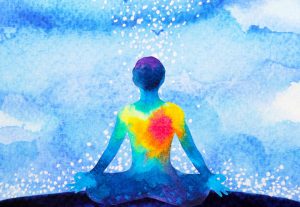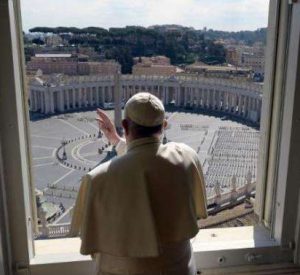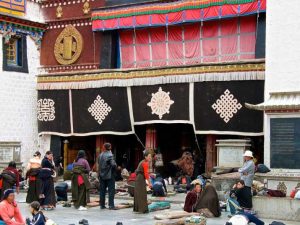
Dr. Bill. M. Mak graduated from Peking University and is currently based in the Department of Indological Studies at Kyoto University.
My Journey as a Buddhist, from Diamond Sutra to Diamond Sutra (Part 3)
The Two Sides of the Buddhism in the Land of Rising Sun
The year I spent in Germany left me with many questions unanswered concerning my identity as a Buddhist. When I arrived in Japan, it was yet another landscape, and a truly bewildering one.
Buddhism seemed to be present everywhere in Japan. Elements of Zen and Pure Land Buddhism had been absorbed into traditional Japanese culture and many Japanese saw their form of Buddhism as the most refined type (and incidentally, also other cultural traits it absorbed from other cultures). In a place like Kyoto, there was hardly a corner where one would not find a temple, or at least a statue of o-jiz?, the ubiquitous Bodhisattva K?itigarbha who vowed to save all suffering souls even in hell. Because of my research and study, I came into contact with many Buddhological scholars, researchers and students in Japan, many of whom were themselves Buddhist priests, or o-b?san. But when I declared myself to be a Buddhist, no one seemed to understand what I meant. To say the least I was no less confounded than my Japanese colleagues.
It is perhaps well-known to many that in Japan, the total sum of people declaring to be belonging to a particular faith (atheist included) is greater than the total population of Japan. But in reality, very few people actually claimed themselves to be Buddhist as far as personal, religious belief is concerned. Many considered themselves Buddhist with a certain affiliation because of one’s ancestors buried in the ground of a certain temple, or in the case of the married priests, it was a family lineage. The concept of lay Buddhist as well as that of the traditional precepts as understood from the Buddhist text had all together disappeared in the long course of evolution of Japanese Buddhism.
It was a revelation to me that in a country where Buddhism had such a strong presence, the concept of a “Buddhist” hardly existed in the mind of the Japanese. Whereas in the West, being a Buddhist at least meant to have a certain set of beliefs or values, individualistically tailored to one’s own taste might it be, the word Buddhist brought about a medley of ideas and associations in Japan. In fact, many of these associations were alarmingly negative as most modern Japanese prided themselves as a free-thinking civilized and advanced people, who revered Buddhism only for its cultural value. Few except the scholars would take it seriously as a philosophy and no one would expect Buddhism to be adopted as a way of life, not to mention a religious faith. People with religious convictions were often viewed with suspect given the history of corruption and abuse of certain religious groups in Japan, Buddhist included. Recent incidents of harmful religious cults further added to the negative imagery of anything “religious”.
Once I was met with a group of young Buddhist priests who tried to revive Buddhism among young university students. To them, my identity as a lay Buddhist was irrelevant since the concept of Sa?gha was very different for them, who saw themselves as professionals taking care of the welfare of only those belonging to their temple. By the word welfare, it meant some form of services which entailed financial transactions such as purchase of a tomb, rendering memorial service to the ancestors or aborted fetuses and so on. When asked why they tried to revive Buddhism when Buddhism was already so well established in Japan, they explained to me that they tried to create a new image for Buddhism in the mind of the public, that it was a religion of life, full of vitality and that it was “fun and cool”. When I saw their pamphlet showing Buddhist priests making grimaces or enjoying beers partying with girls, I could not help but frown, not because of certain moral high ground, but at the apparent lack of taste in trying to appeal to the mass. But after further investigation, I discovered that the unconventional behaviors of the Japanese monks or priests (which were not distinguished in most cases) were, rather than an “expedient means”, in fact a reality which had evolved to its present state under extremely complicated circumstances. A married monk/priest once sipping a glass of beer, blowing cigarette smoke into my face to which I coughed in indignation explained to me that in Japanese Buddhism, the traditional moral percepts had been transcended. He did not bother to give me the explanation as if either he was not in the mood to explain or that I was incapable to comprehend. I hope only the former was true.
Later as a shocking revelation, I discovered that the Japanese Buddhists indeed had a record of moral transcendence during the militarist period. While in retrospect, many expressed their dismay at how religious institutions failed to voice their concerns in view of the atrocities in Nazi Germany or the Japanese invasion of China, it might be come as a surprise to many that not only did the Japanese Buddhists (except Soka Gakkai which most Japanese Buddhists considered to be non-Buddhist) and notable Zen priests not try to stop the war or voice out on the matter, they in fact supported actively the war. Some priests even went into military service as they saw no conflict between the act of murdering one’s adversaries and their percept of non-violence. War criminals were honored not only in the infamous Yasukuni Shrine, but also Buddhist temples and it was only until as recent as 2003 when the Rinzai Sect issued a public apology for its participation in war time efforts during WWII, after a book on the matter was written by the American scholar Brian Victoria, causing an uproar in the West. The esteemed Zen Master Nakajima Genj?, head of the Hakuin branch of Rinzai Zen who claimed to have been enlightened, at the age of 80, lamented in his tearful autobiography, shockingly, not for the victims of the war, but only his dead comrades who had sacrificed themselves, for a war that was poorly engaged. It was with a heavy heart that I came to realize these examples were in fact the norm rather than exception. In fact, there was a history of close connection between the xenophobic and nationalist Right Wing and the upper echelon of Buddhist hierarchy in Japan. It was no wonder that some of my more liberal Japanese friends looked at me with a wide eye when I declared myself to them as Buddhist.
Under such circumstances, there was no point for me to maintain my identity or label as Buddhist, at least not in Japan, as it projected an image, unintended and seemingly unalterable. While in China, I and my co-religionists often discussed the importance of identifying oneself as Buddhist in public as it served the twofold purposes of setting an exemplar of Buddhist values to others and strengthening one’s own conviction. But my experience in Japan shattered my image of the ideal Buddhist.
At this point, I must mention the Diamond Sutra once again. As I shed my former identities, I built up for myself a new identity as a Buddhist. Perhaps it was time for me to shed that Buddhist identity too altogether, an identity which I held dearly to and helped me to win friends and to gain access to knowledge and understanding which I continue to treasure at heart. But if Buddhist is only called a Buddhist and not a Buddhist, how is Buddhism going to live on and how can those sharing the Buddhist faith unite to transform our troubled world into a better place? How can positive values be built on such vacuous principle of Emptiness which poses the constant threatens of auto-deconstruction?
My experience in Japan was an important lesson for me. Though I heed not to sound overly disparaging as if I am condemning others whom I do not see as living up to the Buddhist standard as I understand, the hard truth is that everywhere in the world people acquire labels for themselves for reasons that are not. It could be a means for survival, an aura one tries to project to impress others or even a political tool that entails manipulation and all forms of abuse of power. On the positive side, there are always people who value human kindness and are touched by the humanistic teachings of the great souls of the past and the Buddha just happened to be one of such illuminating sources.
Ultimately, being a Buddhist indeed has little to do with whether one calls oneself a Buddhist or whether what one practices is labeled as Buddhism at all for that matter. Though many answers are still left unanswered and the journey goes on, with this new understanding, I begin to see the Buddhist in everyone and Buddhism everywhere. It is not a label that I superimpose onto anyone or anything that comes into my field of cognition, but rather it is a recognition of the potentiality for goodness ready to blossom everywhere and in everyone when given the right circumstances and when the right factors ripen. In this sense, being a Buddhist is about how one may develop such insight, inspire others and benefit everyone including oneself from the wonderful and wise teachings of someone who had a profound understanding of human nature and the human condition.











